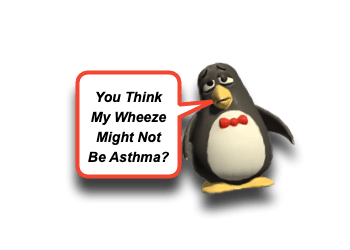Paradoxical Vocal Fold Movement

It is often stated that “not all that Wheezes is Asthma,” but actually recalling what is on that Differential Diagnosis list is challenging. We have discussed several wheeze-related etiologies like Bronchiolitis, Heart Failure, Pneumonia, and Aspirated Foreign Bodies. Similarly, not all Stridor is Croup (ex, Recurrent Croup, RPA, and Tracheitis). Obviously, there are many conditions that need to be considered for these patients presenting with respiratory distress. Let’s take a moment to review one other condition that is often under-appreciated – Paradoxical Vocal Fold Movement:
Paradoxical Vocal Fold Movement: Basics
- Paradoxical Vocal Fold Movement (PVFM) occurs when: [Matrka, 2014; Maturo, 2011]
- the vocal fold(s) episodically, inappropriate constriction during respiration;
- the vocal folds otherwise have normal movement outside these episodes;
- there is no anatomic abnormality (ex, subglottic / tracheal stenosis)
- Can be triggered by: [Ng, 2017; Matrka, 2014; Maturo, 2011]
- Anything that irritates the vocal folds
- Laryngopharyngeal reflux
- Inhaled chemicals
- Tobacco smoke
- Allergic laryngitis
- Viral illness
- Exercise
- Associated particularly with elite athletes.
- Can be true cause of “exercised-induced” dyspnea.
- Stress
- Has been associated with psychiatric ailments, but does NOT need to be present. [Ng, 2017]
- ~30% of patients found to have underlying psychiatric condition (which means ~70% are not). [Maturo, 2011]
- Strong Odors / Perfumes
- Anything that irritates the vocal folds
- Several other terms have been used: [Ng, 2017; Matrka, 2014; Maturo, 2011]
- Vocal Cord Dysfunction, Episodic laryngospasm, Irritable larynx syndrome, Fake asthma, and Munchausen stridor.
- “Paradoxical Vocal Fold Movement” is preferred nomenclature now.
- Likely UNDERdiagnosed. [Matrka, 2014; Maturo, 2011]
- Presentation often mimics other common conditions, like asthma.
- ~40% of patients misdiagnosed with Asthma.
- Diagnosis requires laryngoscopy (direct or fiberscopic).
- H+P will raise suspicion for it.
- Ultrasound may prove to be helpful too. [Finnoff, 2018]
- “Poorly controlled” asthma may, in fact, be PVFM.
- Patients can have both PVFM and Asthma.
- Presentation often mimics other common conditions, like asthma.
- Undiagnosed PVFM has been associated with increased health care costs. [Matrka, 2014; Maturo, 2011]
- Higher utilization of healthcare resources (ex, ED visits, hospitalizations)
- Unnecessary procedures (ex, intubations, tracheostomies)
- Average time between symptom onset and diagnosis is > 4 years. [Maturo, 2011]
PVFM: Presentation
- Symptoms are non-specific and easily mimic other conditions (like Asthma). [Ng, 2017; Matrka, 2014; Maturo, 2011]
- Dyspnea
- Shortness of breath with exercise.
- Throat/Neck Tightness
- Stridor with exercise.
- Symptoms often present abruptly. [Ng, 2017; Matrka, 2014; Maturo, 2011]
- Associated with Exertion
- Associated with Stressful / Emotional situation
- May be raise concern for Acute Asphyxial Asthma.
- Some distinguishing features: [Matrka, 2014]
- Wheezing may be reported, but noisy inspiration more objectively noted. A Prominent Inspiratory component is often noted, although not required.
- Absence of true end-expiratory wheeze is supportive of PVFM.
- In elite athletes, high-intensity activity more likely to lead to symptoms rather than long, lower-intensity exercise.
- Resolves more quickly with rest, compared to exercise-induced asthma.
- Described choking sensation.
- No improvement or alteration in symptoms with bronchodilator therapy.
- Have had a history of normal Pulmonary Function Tests previously.
PVFM: Management
- Don’t jump to conclusions!
- Manage the respiratory distress as your training has taught you.
- Patients with PVFM may have other concurrent conditions, like asthma or croup.
- Heliox may also be helpful acutely. [Ng, 2017]
- Nebulized lidocaine has also been found to be helpful acutely. [Ng, 2017]
- Consider your Ddx.
- “Recurrent croup,” really? Should we recommend an outpatient ENT referral for further assessment of upper airway anomalies?
- PVFM may be associated with psychiatric ailments, so consider the psycho-social implications.
- Do a thorough exam!
- Neurologic conditions may present similarly.
- Dysphagia or Cranial Nerve deficits??
- Cardiovascular entities may also present similarly.
- Chest pain? Syncope? Check that ECG!
- Pay attention to the timing of the “wheeze” or stridor. Don’t forget to listen over the larynx.
- Neurologic conditions may present similarly.
- Know the next steps. [Ng, 2017]
- Main therapy of PVFM is speech therapy and psychiatric therapy.
- Anti-anxiety medications may be helpful.
- Some cases may require surgery.
Moral of the Morsel
- Wheezing doesn’t Equate to Asthma! Keep your Ddx open while treating the patient.
- Refer to your friendly ENT and/or Speech Pathologist for further evaluation if suspicious! You may not make the Dx, but your attention will place the patient on the right path!
References
Finnoff JT1, Orbelo DM2, Ekbom DC2. Can Ultrasound Identify Paradoxical Vocal Fold Movement? A Pilot Study. Clin J Sport Med. 2018 Aug 8. PMID: 30095506. [PubMed] [Read by QxMD]
Ng TT1. The forgotten cause of stridor in the emergency department. Open Access Emerg Med. 2017 Jan 16;9:19-22. PMID: 28144169. [PubMed] [Read by QxMD]
Kramer S1, deSilva B1, Forrest LA1, Matrka L1. Does treatment of paradoxical vocal fold movement disorder decrease asthma medication use? Laryngoscope. 2017 Jul;127(7):1531-1537. PMID: 27861929. [PubMed] [Read by QxMD]
Matrka L1. Paradoxic vocal fold movement disorder. Otolaryngol Clin North Am. 2014 Feb;47(1):135-46. PMID: 24286687. [PubMed] [Read by QxMD]
Franca MC1. Differential diagnosis in paradoxical vocal fold movement (PVFM): an interdisciplinary task. Int J Pediatr Otorhinolaryngol. 2014 Dec;78(12):2169-73. PMID: 25455524. [PubMed] [Read by QxMD]
Koufman JA1, Block C. Differential diagnosis of paradoxical vocal fold movement. Am J Speech Lang Pathol. 2008 Nov;17(4):327-34. PMID: 18840701. [PubMed] [Read by QxMD]


Still enjoying reading your morsels during my PICU fellowship; thanks for continuing to keep things relevant and timely! AAP section on Otolaryngology released a summary on PVFM the same day you did (link below) but I find your summary more clinically relevant for us first-line providers. Keep up the good FOAM fight!
Dr. McCaw,
I am glad you are enjoying your fellowship! Thank you for the reference!
All the best,
sean